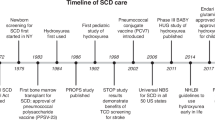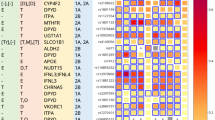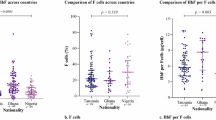Abstract
In sub-Saharan Africa, sickle cell disease (SCD) remains a significant public health challenge. Despite the discovery of SCD over a century ago, progress in developing and accessing effective treatments has been limited. Hydroxyurea is the primary drug used for managing SCD and associated with improving clinical outcomes. However, up to 30% of patients do not respond to hydroxyurea, likely due to genetic factors. This study involved 148 individuals with SCD investigated the association of hydroxyurea response with genetic variants across 13 loci associated with HbF synthesis and drug metabolism, focusing on MYB, HBB, HBG1, HBG2, BCL11A, KLF10, HAO2, NOS1, ARG2, SAR1A, CYP2C9, and CYP2E1. Significant associations with hydroxyurea response were identified in CYP2C9, CYP2E1, KLF10, BCL11A, ARG2, HBG1, SAR1A, MYB, and NOS1 loci. Furthermore, pathway enrichment and gene-gene interaction analyses provide deeper insights into the genetic mechanisms underlying hydroxyurea treatment response, highlighting potential avenues for personalized therapy in SCD management.
This is a preview of subscription content, access via your institution
Access options
Subscribe to this journal
Receive 6 print issues and online access
$259.00 per year
only $43.17 per issue
Buy this article
- Purchase on SpringerLink
- Instant access to full article PDF
Prices may be subject to local taxes which are calculated during checkout




Similar content being viewed by others
Data availability
Genomic sequencing data generated in this study have been submitted to the NCBI BioProject database (https://www.ncbi.nlm.nih.gov/bioproject/) under accession number PRJNA1114738. The original contributions presented in the study are included in the article/supplementary material, further inquiries contributions presented in the study are included in the article/supplementary material, further inquiries can be directed to the corresponding authors.
References
How I use hydroxyurea to treat young patients with sickle cell anemia blood American society of hematology. Blood. 2010;115:5300–11. Available from: https://ashpublications.org/blood/article/115/26/5300/130853/How-I-use-hydroxyurea-to-treat-young-patients-with
Tshilolo L, Tomlinson G, Williams TN, Santos B, Olupot-Olupot P, Lane A. Hydroxyurea for children with sickle cell anemia in sub-saharan Africa. N Engl J Med. 2019;380:121–31.
John CC, Opoka RO, Latham TS, Hume HA, Nabaggala C, Kasirye P. Hydroxyurea dose escalation for sickle cell anemia in sub-saharan Africa. N Engl J Med. 2020;382:2524–33.
McGann PT, Niss O, Dong M, Marahatta A, Howard TA, Mizuno T, et al. Robust clinical and laboratory response to hydroxyurea using pharmacokinetically guided dosing for young children with sickle cell anemia. Am J Hematol. 2019;94:871–9.
Ginete C, Delgadinho M, Santos B, Pinto V, Silva C, Miranda A. Are genetic modifiers the answer to different responses to hydroxyurea treatment?-a pharmacogenetic study in sickle cell anemia angolan children. Int J Mol Sci. 2023;24:8792.
Walker AL, Franke RM, Sparreboom A, Ware RE. Transcellular movement of hydroxyurea is mediated by specific solute carrier transporters. Exp Hematol. 2011;39:446–56.
Green NS, Barral S. Emerging science of hydroxyurea therapy for pediatric sickle cell disease. Pediatr Res. 2014;75:196–204.
Rappaport SM. Genetic factors are not the major causes of chronic diseases. PLoS ONE. 2016;11:e0154387.
Sheehan VA, Crosby JR, Sabo A, Mortier NA, Howard TA, Muzny DM, et al. Whole exome sequencing identifies novel genes for fetal hemoglobin response to hydroxyurea in children with sickle cell anemia. PLoS ONE. 2014;9:e110740.
Nkya S, Nzunda C, Saukiwa E, Kaywanga F, Solomon D, Christopher H. Towards genomic medicine: a tailored next-generation sequencing panel for hydroxyurea pharmacogenomics in Tanzania. BMC Med Genomics. 2024;17:190.
Van der Auwera GA, Carneiro MO, Hartl C, Poplin R, Del Angel G, Levy-Moonshine A. From FastQ data to high confidence variant calls: the genome analysis toolkit best practices pipeline. Curr Protoc Bioinformatics. 2013;43:11.10.1–11.10.33.
Cock PJA, Fields CJ, Goto N, Heuer ML, Rice PM. The Sanger FASTQ file format for sequences with quality scores, and the Solexa/Illumina FASTQ variants. Nucleic Acids Res. 2010;38:1767–71. https://doi.org/10.1093/nar/gkp1137
Rosenbloom KR, Armstrong J, Barber GP, Casper J, Clawson H, Diekhans M. The UCSC genome browser database: 2015 update. Nucleic Acids Res. 2015;43:D670–81. https://doi.org/10.1093/nar/gku1177
Li H, Durbin R. Fast and accurate short read alignment with burrows-wheeler transform. Bioinformatics. 2009;25:1754–60.
Li H, Ruan J, Durbin R. Mapping short DNA sequencing reads and calling variants using mapping quality scores. Genome Res. 2008;18:1851–8.
Ewels P, Magnusson M, Lundin S, Käller M. MultiQC: summarize analysis results for multiple tools and samples in a single report. Bioinformatics. 2016;32:3047–8.
McKenna A, Hanna M, Banks E, Sivachenko A, Cibulskis K, Kernytsky A. The genome analysis toolkit: a mapReduce framework for analyzing next-generation DNA sequencing data. Genome Res. 2010;20:1297–303.
Depristo MA, Banks E, Poplin R, Garimella KV, Maguire JR, Hartl C, et al. A framework for variation discovery and genotyping using next-generation DNA sequencing data. Nat Genet. 2011;43:491–501.
Li H. A statistical framework for SNP calling, mutation discovery, association mapping and population genetical parameter estimation from sequencing data. Bioinformatics. 2011;27:2987–93.
Gézsi A, Bolgár B, Marx P, Sarkozy P, Szalai C, Antal P. VariantMetaCaller: automated fusion of variant calling pipelines for quantitative, precision-based filtering. BMC Genomics. 2015;16:875.
Auton A, Salcedo T. The 1000 genomes project. In: Zeggini E, Morris A, editors. Assessing rare variation in complex traits: design and analysis of genetic studies. New York, NY: Springer; 2015;71–90. https://doi.org/10.1007/978-1-4939-2824-8_6
Auton A, Abecasis GR, Altshuler DM, Durbin RM, Bentley DR, Chakravarti A, et al. A global reference for human genetic variation. Nature. 2015;526:68–74.
Sherry S, Ward M, Kholodov M, Baker J, Phan L, Smigielski E, et al. dbSNP: the NCBI database of genetic variation. Nucleic Acids Res. 2001;29:308–11.
Wang K, Li M, Hakonarson H. ANNOVAR: functional annotation of genetic variants from high-throughput sequencing data. Nucleic Acids Res. 2010;38:e164.
Karczewski KJ, Weisburd B, Thomas B, Solomonson M, Ruderfer DM, Kavanagh D, et al. The ExAC browser: displaying reference data information from over 60,000 exomes. Nucleic Acids Res. 2017;45:D840–D845. https://doi.org/10.1093/nar/gkw971
Forbes SA, Beare D, Gunasekaran P, Leung K, Bindal N, Boutselakis H, et al. COSMIC: exploring the world’s knowledge of somatic mutations in human cancer. Nucleic Acids Res. 2015;43:805–11.
O’Leary NA, Wright MW, Brister JR, Ciufo S, Haddad D, McVeigh R, et al. Reference sequence (RefSeq) database at NCBI: current status, taxonomic expansion, and functional annotation. Nucleic Acids Res. 2016;44:D733–45.
Chun S, Fay JC. Identification of deleterious mutations within three human genomes. Genome Res. 2009;19:1553–61. https://doi.org/10.1101/gr.092619.109
Lubeck E, Coskun AF, Zhiyentayev T, Ahmad M, Cai L. MutationTaster2: mutation prediction for the deep-sequencing age. Nat Methods. 2012;9:743.
Reva B, Antipin Y, Sander C. Predicting the functional impact of protein mutations: application to cancer genomics. Nucleic Acids Res. 2011;39:37.
Shihab HA, Gough J, Cooper DN, Day INM, Gaunt TR. Predicting the functional consequences of cancer-associated amino acid substitutions. Bioinformatics. 2013;29:1504–10.
Kircher M. A general framework for estimating the relative pathogenicity of human genetic variants. Nat Genet. 2014;46:310.
Rentzsch P, Witten D, Cooper GM, Shendure J, Kircher M. CADD: Predicting the deleteriousness of variants throughout the human genome. Nucleic Acids Res. 2019;47:D886–D894.
Davydov EV, Goode DL, Sirota M, Cooper GM, Sidow A, Batzoglou S. Identifying a high fraction of the human genome to be under selective constraint using GERP++. PLoS Comput Biol. 2010;6:e1001025.
Quang D, Chen Y, Xie X. DANN: a deep learning approach for annotating the pathogenicity of genetic variants. Bioinformatics. 2015;31:761–3.
Adzhubei IA, Schmidt S, Peshkin L, Ramensky VE, Gerasimova A, Bork P, et al. A method and server for predicting damaging missense mutations. Nat Methods. 2010;7:248.
Garber M, Guttman M, Clamp M, Zody MC, Friedman N, Xie X. Identifying novel constrained elements by exploiting biased substitution patterns. Bioinformatics. 2009;25:54.
Ashburner M, Ball CA, Blake JA, Butler H, Cherry JM, Eppig JT, et al. Creating the gene ontology resource: design and implementation. Genome Res. 2001;11:1425–33. https://doi.org/10.1101/gr.180801
Purcell S, Neale B, Todd-Brown K, Thomas L, Ferreira MAR, Bender D, et al. PLINK: A tool set for whole-genome association and population-based linkage analyses. Am J Hum Genet. 2007;81:559–75.
Patterson N, Price AL, Reich D. Population structure and eigenanalysis. PLoS Genet. 2006;2:2074.
Price AL, Patterson NJ, Plenge RM, Weinblatt ME, Shadick NA, Reich D. Principal components analysis corrects for stratification in genome wide association studies. Nat Genet. 2006;38:904.
Genesis can be used to display screen and publication quality pictures of population PCA and admixture charts | Genesis PCA and Admixture Plot Viewer. 2014. Available from: https://www.bioinf.wits.ac.za/software/genesis/.
Warde-Farley D, Donaldson SL, Comes O, Zuberi K, Badrawi R, Chao P, et al. The GeneMANIA prediction server: biological network integration for gene prioritization and predicting gene function. Nucleic Acids Res. 2010;38:W214–20. https://doi.org/10.1093/nar/gkq537
Chen EY, Tan CM, Kou Y, Duan Q, Wang Z, Meirelles GV, et al. Enrichr: interactive and collaborative HTML5 gene list enrichment analysis tool. BMC Bioinformatics. 2013;14:128.
Yawn BP, Buchanan GR, Afenyi-Annan AN, Ballas SK, Hassell KL, James AH, et al. Management of sickle cell disease: summary of the 2014 evidence-based report by expert panel members. JAMA. 2014;312:1033–48. https://doi.org/10.1001/jama.2014.10517
Chand AR, Xu H, Wells LG, Clair B, Neunert C, Spellman AE, et al. Are there true non-responders to hydroxyurea in sickle cell disease? a multiparameter analysis. Blood. 2014;124:4073.
Ma Q, Wyszynski DF, Farrell JJ, Kutlar A, Farrer LA, Baldwin CT, et al. Fetal hemoglobin in sickle cell anemia: Genetic determinants of response to hydroxyurea. Pharmacogenomics J. 2007;7:386–94. https://doi.org/10.1038/sj.tpj.6500433
Molokie R, Lavelle D, Gowhari M, Pacini M, Krauz L, Hassan J, et al. Oral tetrahydrouridine and decitabine for non-cytotoxic epigenetic gene regulation in sickle cell disease: a randomized phase 1 study. PLoS Med. 2017;14:e1002382 https://doi.org/10.1371/journal.pmed.1002382
Niihara Y, Miller ST, Kanter J, Lanzkron S, Smith WR, Hsu LL, et al. A phase 3 trial of l -glutamine in sickle cell disease. N Engl J Med. 2018;379:226–35. https://doi.org/10.1056/nejmoa1715971
Kutlar A, Kanter J, Liles DK, Alvarez OA, Cançado RD, Friedrisch JR, et al. Effect of crizanlizumab on pain crises in subgroups of patients with sickle cell disease: a SUSTAIN study analysis. Am J Hematol. 2019;94:55–61. https://doi.org/10.1002/ajh.25308
Howard J, Hemmaway CJ, Telfer P, Layton DM, Porter J, Awogbade M, et al. A phase 1/2 ascending dose study and open-label extension study of voxelotor in patients with sickle cell disease. Blood. 2019;133:1865–75.
Lanzkron S, Strouse JJ, Wilson R, Beach MC, Haywood C, Park H, et al. Systematic review: Hydroxyurea for the treatment of adults with sickle cell disease. Ann Intern Med. 2008;148:939–55. https://doi.org/10.7326/0003-4819-148-12-200806170-00221
Charache S, Terrin ML, Moore RD, Dover GJ, Barton FB, Eckert SV, et al. Effect of hydroxyurea on the frequency of painful crises in sickle cell anemia. Investigators of the multicenter study of hydroxyurea in sickle cell anemia. N Engl J Med. 1995;332:1317–22.
Bridges KR, Barabino GD, Brugnara C, Cho MR, Christoph GW, Dover G, et al. A multiparameter analysis of sickle erythrocytes in patients undergoing hydroxyurea therapy. Blood. 1996;88:4701–10. https://doi.org/10.1182/blood.v88.12.4701.bloodjournal88124701
Mtatiro SN, Makani J, Mmbando B, Thein SL, Menzel S, Cox SE. Genetic variants at HbF-modifier loci moderate anemia and leukocytosis in sickle cell disease in Tanzania. Am J Hematol. 2015;90:E1–4. https://doi.org/10.1002/ajh.23859
Subotički T, Mitrović Ajtić O, Djikić D, Kovačić M, Santibanez JF, Tošić M, et al. Nitric oxide mediation in hydroxyurea and nitric oxide metabolites’ inhibition of erythroid progenitor growth. Biomolecules. 2021;11:1562 https://doi.org/10.3390/biom11111562
Daly AK, Rettie AE, Fowler DM, Miners JO. Pharmacogenomics of CYP2C9: Functional and clinical considerations. J Pers Med. 2018;8:1 https://doi.org/10.3390/jpm8010001
Garciá-Suástegui WA, Ramos-Chávez LA, Rubio-Osornio M, Calvillo-Velasco M, Atzin-Méndez JA, Guevara J, et al. The role of CYP2E1 in the drug metabolism or bioactivation in the brain. Oxid Med Cell Longev. 2017;2017:4680732 https://doi.org/10.1155/2017/4680732
Manu GP, Segbefia C, N’guessan BB, Coffie SA, Adjei GO. Association between selected single nucleotide polymorphisms in globin and related genes and response to hydroxyurea therapy in ghanaian children with sickle cell disease. Pharmgenomics Pers Med. 2022;15:205–14. https://doi.org/10.2147/PGPM.S351599
Green NS, Barral S. Genetic modifiers of HbF and response to hydroxyurea in sickle cell disease. Pediatr Blood Cancer. 2011;56:177–81. https://doi.org/10.1002/pbc.22754
Green NS, Ender KL, Pashankar F, Driscoll C, Giardina PJ, Mullen CA, et al. Candidate sequence variants and fetal hemoglobin in children with sickle cell disease treated with hydroxyurea. PLoS ONE. 2013;8:e55709 https://doi.org/10.1371/journal.pone.0055709
Chaparro M, Aterido A, Guerra I, Iborra M, Cabriada JL, Bujanda L, et al. Functional rare variants influence the clinical response to anti-TNF therapy in Crohn’s disease. Therap Adv Gastroenterol. 2019;12:1756284819867848 https://doi.org/10.1177/1756284819867848
Nelson MR, Marnellos G, Kammerer S, Hoyal CR, Shi MM, Cantor CR, et al. Large-scale validation of single nucleotide polymorphisms in gene regions. Genome Res. 2004;14:1664–8. https://doi.org/10.1101/gr.2421604
Memon N, Weinberger BI, Hegyi T, Aleksunes LM. LiverTox: clinical and research information on drug-induced liver injury. Bethesda (MD): National Institute of Diabetes and Digestive and Kidney Diseases; 2012. Available from: https://www.ncbi.nlm.nih.gov/books/NBK547852/
Zhou Y, Lauschke VM. The genetic landscape of major drug metabolizing cytochrome P450 genes—an updated analysis of population-scale sequencing data. Pharmacogenomics J. 2022;22:284–93. https://doi.org/10.1038/s41397-022-00288-2
Vinhaes CL, Teixeira RS, Monteiro-Júnior JAS, Tibúrcio R, Cubillos-Angulo JM, Arriaga MB, et al. Hydroxyurea treatment is associated with reduced degree of oxidative perturbation in children and adolescents with sickle cell anemia. Sci Rep. 2020;10:18982 https://doi.org/10.1038/s41598-020-76075-5
Acknowledgements
The Sickle cell Program and the Haematology Clinical and Research Laboratory of the Department of Haematology and Blood Transfusion, Muhimbili University of Health and Allied Sciences is highly appreciated for the cooperation shown during the whole time of study.
Author information
Authors and Affiliations
Contributions
SN contributed to conceptualization, funding acquisition, supervision, and project administration. CN, ERC, EB, ES, FK, HC, and MZ were involved in data curation, formal analysis, investigation, methodology, and software development. ERC, CN, SN, and CD contributed to writing, review and editing, conceptualization, methodology, supervision, validation, resources, and visualization. DS, DN, JJ, FU, JM, SK, RS, CC, JM, CK, MY, and EN critically reviewed the data and edited the manuscript. All authors read and approved the final version of the manuscript.
Corresponding author
Ethics declarations
Competing interests
The authors declare no competing interests.
Ethical approval and consent to participate
This study received ethical approval from the Institutional Review Board at Muhimbili University of Health and Allied Science, number MUHAS-REC-2018-078. Both verbal and written consent were obtained from mothers to agree their babies to participate in this study. Informed consent to participate was obtained from the parents or legal guardians of any participant under the age of 16. Consent forms were signed by the mothers or legal guardians who agreed to their children to participate after the research assistant educated them.
Additional information
Publisher’s note Springer Nature remains neutral with regard to jurisdictional claims in published maps and institutional affiliations.
Supplementary information
Rights and permissions
Springer Nature or its licensor (e.g. a society or other partner) holds exclusive rights to this article under a publishing agreement with the author(s) or other rightsholder(s); author self-archiving of the accepted manuscript version of this article is solely governed by the terms of such publishing agreement and applicable law.
About this article
Cite this article
Nkya, S., Nzunda, C., Saukiwa, E. et al. Exploring pharmacogenetic factors influencing hydroxyurea response in tanzanian sickle cell disease patients: a genomic medicine approach. Pharmacogenomics J 25, 11 (2025). https://doi.org/10.1038/s41397-025-00372-3
Received:
Revised:
Accepted:
Published:
DOI: https://doi.org/10.1038/s41397-025-00372-3



